The Easter Island Virtual Challenge takes you 61 kilometres from Hanga Roa, heading through the centre of the island, then back to Hanga Roa. Easter Island is famous for the Moai statues created and scattered across the island by its early inhabitants, the Rapa Nui.
- Short challenges help build confidence when things get wobbly.
- Things got wobbly.
- I’m working on it.
Tune in for the next post, by which point I hope to actually have some content. Right now, all I have behind me are kilometres.
Postcards
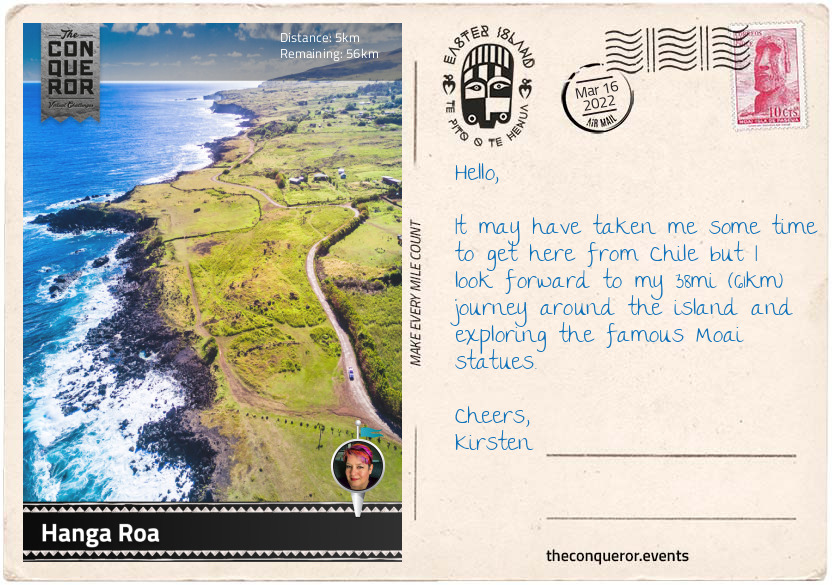
The island of Rapa Nui, commonly known as Easter Island, is one of the most isolated places in the world, located 2,180mi (3,500km) west of continental Chile in the South Pacific Ocean. A UNESCO World Heritage Site since 1995, Easter Island is famous for its collection of monolithic statues, known as Moai and the unusual Birdman Cult.
The island’s beginning is a little sketchy with most of what is known obtained either from oral recordings or archaeological excavations. Settled by Polynesians, radiocarbon dating suggests arrival around 1200 AD, however, some scholars posit that colonisation may have occurred as early as 700 AD.Oral history tells the story of Hotu Matu’a, a tribal chief from somewhere near the Marquesas Islands (about 2,000mi / 3,200km northeast of Easter Island), who had a dream about an island called Te Pito ‘o te Kāinga, meaning “the centre of the earth”. Gathering a scouting crew, Hotu sent them on a voyage to search for the island, eventually finding Rapa Nui. After a short rest they returned to tell the chief the news, who then left in a double-hulled canoe and landed at Anakena beach.
Over time the islanders split into two major clans who were often in conflict with one another, competing in who could build the bigger Moai and when that didn’t help resolve their issues, they would turn to war and toppling each other’s statues.
The first European contact was in 1722 when Dutch explorer, Jacob Roggeveen landed on the island on Easter Sunday, which is how the island got its name. He was followed by the Spaniards in 1770, Captain Cook in 1774 and the French in 1786.
With the exception of a few passing ships, the next round of visitors were Peruvian slave-traders who in 1862 carried off 1,500 islanders, about half the population. Only a dozen of the islanders returned to Rapa Nui bringing smallpox with them, which decimated the remainder of the population including the bearers of the island’s culture, history and rongorongo script experts.
Christian missionaries arrived in 1864 with the aim to stamp out the islanders’ culture by banning how they dressed, their tattoos and their body paint, essentially destroying their history, leaving little record of their past. By 1878 only 111 native people existed on the island. Annexation to Chile in 1888 all but sealed the islanders’ fate and their Rapa Nui culture had vanished.
The local natives continued to live under severe controls until the mid-20th century when the tourist trade and commercial interests from around the world began to turn things around for the population. Extensive archaeological studies on the island have been ongoing for over a century with special interest in the Moai statues.
This journey begins in Hanga Roa, the capital of Easter Island. I will be travelling west to Orongo where the story of the birdman cult will unfold; then south to Ahu Tongariki with its 15 standing statues; swinging northwest to Anakena, the landing place of legendary tribal chief Hotu Matu’a; and finally, heading west through the centre of the island back to Hanga Roa.
Time to head to Orongo.
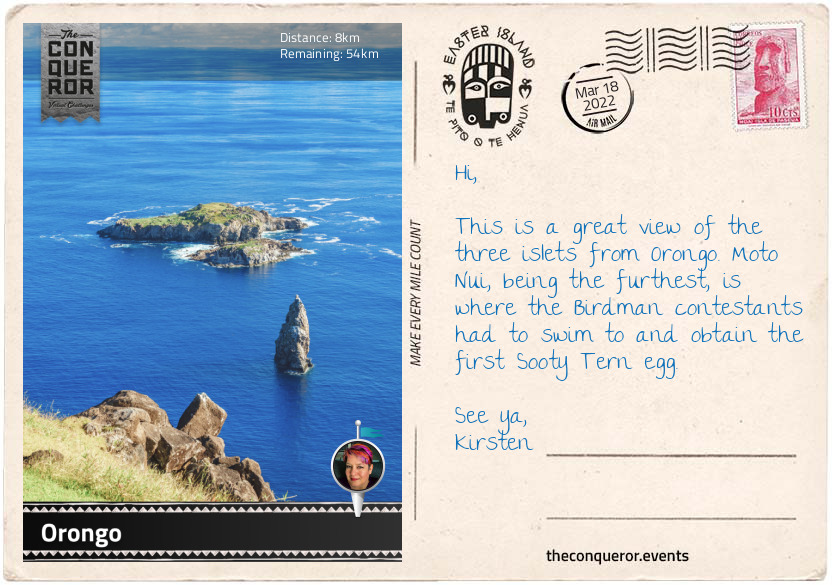
Leaving Ranga Roa, I had a gentle uphill hike for about 3.5mi (5.6km) to Orongo. The terrain is mostly grassland with spots of woodland on either side of the trail leading to the edge of Rano Kau, a dormant volcano with a massive crater lake. Skirting around the crater’s edge, I arrive at the ceremonial village of Orongo.
The village is located on the edge of the crater wall with a gentle grassy slope on one side and a 980ft (300m) sheer cliff drop into the ocean on the other. The village consists of 50+ restored stone houses that were originally built around 1400 AD and later centred around the Tangata Manu (Birdman Cult) ceremony. Each house is oval in shape with a grassy rooftop and an internal height of between 3-6.5ft (1-2m), making it impossible to stand up in most of them. The doorway is extremely low, requiring a person to crawl in order to enter the building. Internal wall paintings depict images of bird-headed men, some carrying eggs, that relate to the Birdman Cult.
In the centre of the village, one of the buildings once housed Hoa Hakananai’a, an 8ft (2.5m) tall basalt Moai. A rare piece, as it is one of only 14 made of basalt, the statue was extracted in 1868 by the crew of an English battleship (HMS Topaze) and transported back to England. It weighs approximately 4.2 tonnes and took about 500 people to get it on the ship. Today, it can be viewed in the British Museum.
Sometime around 1760 AD, a new ritual began in Orongo. Each year, chief male members of prominent families would gather at the village and select a hopu manu (a servant or male of lesser status) to compete in collecting the first Sooty Tern egg from the rocky islet of Motu Nui. The patron of the winning competitor would then be declared Tangata Manu and go into seclusion for a year where he would be considered sacred, spending time eating, sleeping and showered with gifts of food. His clan would also have sole rights to the wild birds’ eggs and fledglings on Moto Nui during this period.
However, the competition was incredibly treacherous. The competitor would first descend 300m down the sheer cliff face to the shore. If he made it intact then, with the help of a narrow float made of reed, he would swim for a kilometre (4,000ft) through strong currents frequented by sharks to Moto Nui, the furthest of three islets. Here, he would wait for days and sometimes weeks for the arrival of the Sooty Terns. During this waiting period, contestants would often pit against each other, stealing food and taking refuge in the numerous caves on the islet.
The contestant to obtain the first egg would then shout his patron’s name, place the sacred egg in a reed basket tied to his head, swim back to Rapa Nui, climb back up the cliff face and present it to his patron. As you might imagine many contestants met with tragedy either by falling from the cliff face, drowning or shark attack. This tradition lasted for 118 years, when it was suppressed by the missionaries.
I marvel at the bravery of these men who undertook such a perilous journey, in order to bestow honour upon their patron.
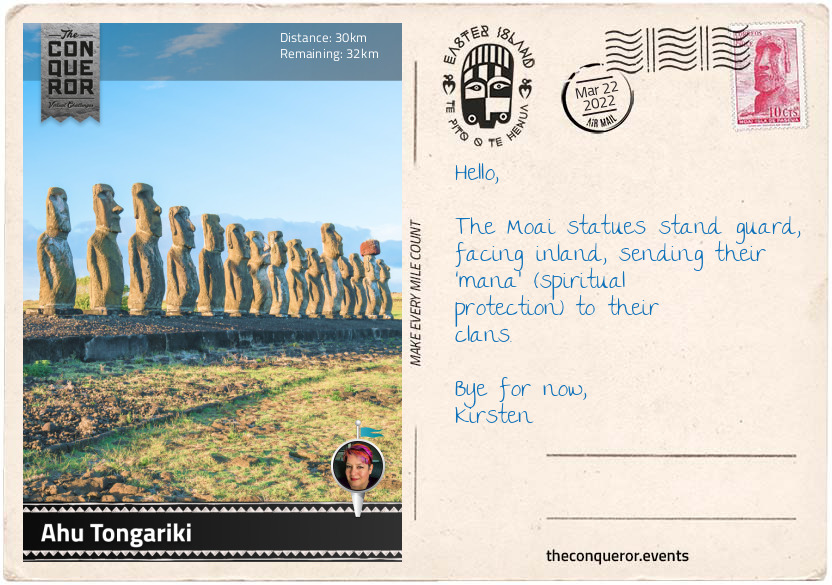
I made my way down the hill where I came upon Ahu Vinapu, a ceremonial platform with incredibly precise stonemasonry that once used to carry Moai statues. The Moai were knocked down between the 18th-19th centuries during the warring periods between clans. Six of them are visible, face down on the ground. Nearby is a buried Moai from which only the head protrudes.
Travelling along the southern coastline of the island, my next stop was Akahanga, an ancient village where Hotu Matu’a is said to have been buried. Here, the ahu, a 59ft (18m) long platform with 13 toppled statues has been left unrestored to illustrate the decline of Rapa Nui culture.
The ahu were sacred platforms dedicated to ancestor worship. On top were the famous Moai statues, each with its own name. When a king died, a statue was erected in his name.
The largest platform is at Ahu Tongariki, about 5mi (8km) east of Akahanga. At 330ft (100m) in length the ahu holds 15 Moai of varying heights and sizes. The tallest is 28ft (8.6m) and weighs 86 tonnes. Originally all the statues had a pukao (ceremonial hats) but only one remains with it on.
The statues have a minimalist, consistent form. Column-shaped, they have an elongated head, long ears, long nose and protruding lips. The eyes are sunken and hollow but at one time the eyes were filled with coral and black obsidian or red scoria as the pupils. The body is squatting with arms in various positions and without legs.
The Moai are made of tuff quarried from the nearby Rano Raraku, a volcanic crater. Most of the carving occurred at the quarries by chipping away at the rock until most of the sculpture emerged. It was then smoothed with pumice and prepared for transportation. Evidence indicates that ropes and wooden sleds on rollers pulled by a large group of islanders were used to transport the statues to their ahu. A stone ramp with levers was then built to help push the Moai into position. Once upright the carvers would complete the back of the statue, and the ramp and levers were removed.
A significant amount of finished and unfinished statues remains in the main quarry, with hundreds more scattered on the grounds, buried up to their necks. For a long time and many still think that the heads were all there was to the statues. However, following an extensive study, archaeologists excavated two statues revealing their hidden bodies. The statues with only the heads visible are a result of the island’s natural erosion. A build up of rocks and sediment over centuries buried the statues, preserving their torsos and the etched petroglyphs on their back.
With nearly 1,000 statues discovered, the task of carving, transporting and placing them all over the island would have been a monumental and physically wearing task.
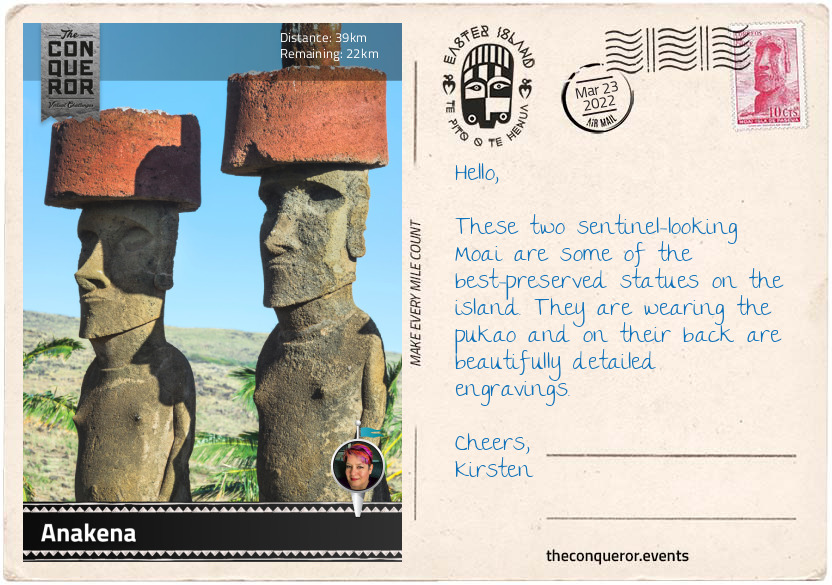
Heading north, I passed Poike, an extinct volcano and the oldest of the main three on the island. Poike used to be an island initially until it was joined by lava flows from Taraveka, the biggest volcano located north of the island.
Following the bend in the road, I turned left and carried on to about halfway between the bend and Anakena Beach. A dirt road led to the Te Pito Kura archaeological complex in front of the Bay La Pérouse where the tallest, once-standing, Moai known as Paro lies. Believed to be commissioned by a widow for her late husband, Paro is 33ft (10m) tall and weighs about 80 tonnes. His ears alone are 6.5ft (2m) long. Unfortunately, Paro was toppled face down during the tribal wars and he split in two. His 10 tonnes pukao (hat) lies beside the head.
A short distance from Paro is a large egg-shaped stone about 80cm in diameter, referred to as Te Pito O Te Henua, meaning “navel of the world”. Legend says that Hotu Matu’a, brought the stone with him from his native land because it was believed that it held a supernatural energy called mana.
Back on the road, I continued to Anakena Beach where Hotu Matu’a made his first landing. Anakena is a pristine white beach with turquoise seas lapping on its shores. In the centre of the beach is the beautifully preserved Ahu Nau Nau, topped with seven Moai of which four are fully intact and wearing the pukao. They were restored in the late 1970s and placed back on the ahu. Because the statues were toppled prior to restoration, over time they were covered by sand. This in turn protected them from erosion and saved the detailed engravings on their back.
To the right of the beach is a singular Moai known as Ahu Ature Huki. This was the first statue to be re-erected using traditional methods. Explorer Thor Heyerdahl, stayed on the island in the mid-1950s and he encouraged the islanders to raise the statue. Using wooden poles, stones and ropes, it took a dozen men eighteen days to place the statue back on the ahu.
Anakena was also an important gathering place for the masters of the rongorongo scripture, a writing system based on glyphs carved on wood or tablets. There are theories about its origins but there is no evidence to substantiate any of them. It is an interesting writing style because the odd lines are written left to right and the even lines are written right to left and upside down. In order to read the even lines, the tablet has to be turned 180 degrees. No one has been able to decipher the system yet. The majority of the tablets were destroyed and the few that survived, about 27, reside in museums around the world. No original pieces are left on Easter Island.
Leaving the sunny beach of Anakena, I began my westward journey back towards Hanga Roa with a stopover at Puna Pau.
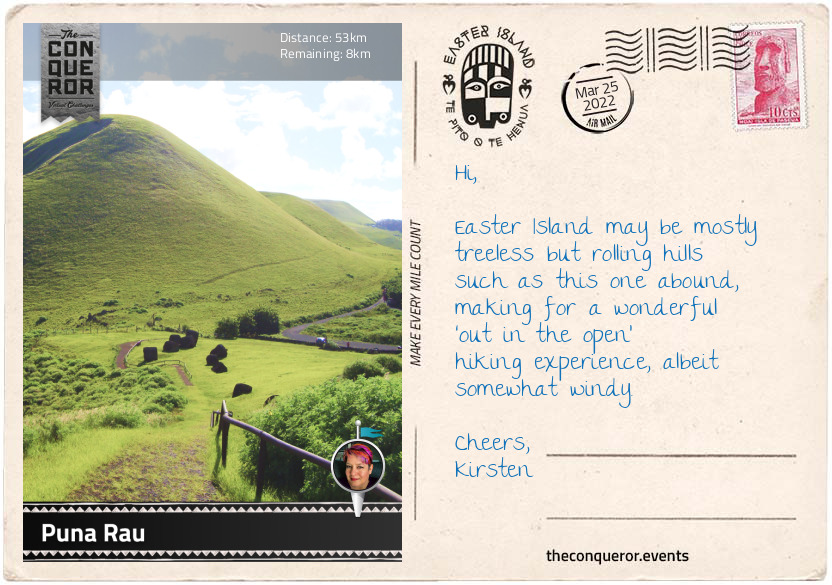
The journey through the centre of the island is along endless meadows and rolling hills. What stands out significantly is the lack of trees, which is the same for most of the island. There are patches here or there but most are not native to Rapa Nui.
When the first settlers arrived with some unsuspecting guests, the Polynesian rat, Rapa Nui was teeming with native palms and other large trees. Pollen and nut studies on the island suggest that they likely belonged to native, giant, palm trees similar to Jubaea, a Chilean sugar palm tree that grows up to 60ft (18m) in height.
The palm tree had many uses. A tapped palm tree would yield over 400 litres of sap that was used as a sweet and nutritious beverage. Its core would be harvested and the nuts collected for food. Along with other tree types, the palm was also used for thatching, making ropes and clothes, weaving mats and baskets, and building canoes, levers and sails.
The rats that hitched a ride found an abundance of food with no natural predators besides the humans. Feasting on the unlimited supply, they multiplied exponentially, doubling almost every six weeks.
Within a few centuries, the island could no longer sustain the excessive needs of its occupants nor its population growth. At its height, Rapa Nui had as many as 15,000 inhabitants and who knows how many rats. Usage outgrew new growth and by late 17th century the island was treeless.
The effects of overharvesting began with deforestation. With no trees, the islanders couldn’t build their canoes to fish, diminishing their food source and their ability to search for food elsewhere. Island-bound, they were also unable to reduce the population through migration.
Native land birds went extinct and the trees could no longer disperse their pollen. More than 20 plant species disappeared. With no supply of timber, the Moai could no longer be transported, thereby abandoning this ceremonial practice and replacing it with the Birdman Cult.
The Rapanui found themselves in an ecological trap. Famine followed causing significant social upheaval. By the time the Europeans’ arrived, the population dropped to around 2,000 inhabitants and the island was devoid of trees.
Today, Easter Island has only 5% arboreal coverage whilst two-thirds of it suffers from erosion caused by climate change with Poike the most affected. Reforesting programs are underway but given the island’s open and windy environment and lack of soil nutrients, the process will take time.
For now, the Australian eucalyptus tree seems to be doing well on the island regardless of the environment and I enjoyed seeing patches of them as I progressed towards Puna Rau.
Puna Rau is a small extinct volcano and the quarry of red scoria, the material used to make the pukao. The scoria is a type of volcanic ash that is highly porous with a reddish tint due to the iron oxide composition. It is soft and easy to carve making it a desirable rock for the pukao and other small items but unsuitable for large scale carvings like the Moai.
Given the sheer size and weight of the pukao, it is surmised that the islanders used their cylindrical shape to roll them on custom-built roads to their destination. It is also thought that the pukao was added to the Moai either by using ramps and rolling it on top of the standing statue or attaching it to the statue if in a lying position with ropes and then elevating it all as one piece.
Rolling off the hilltop, I make my way back to Hanga Roa.
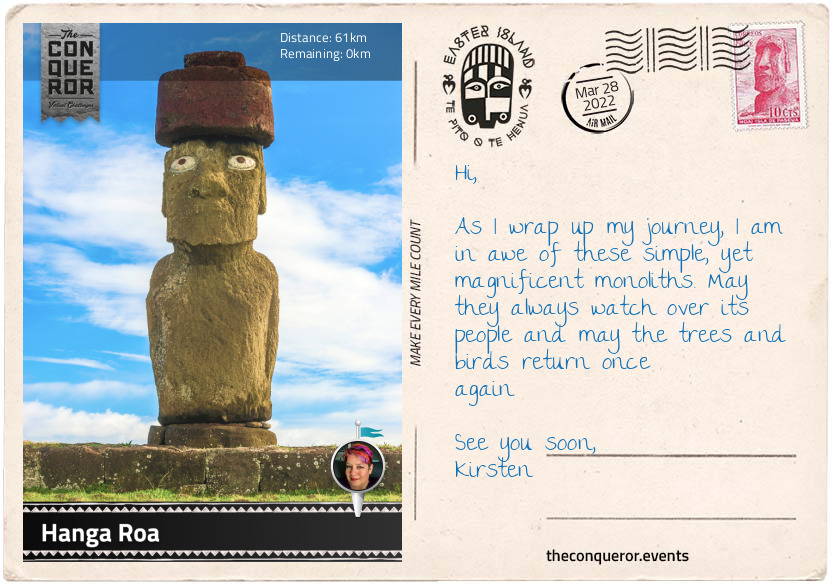
Back in Hanga Roa, I took a side trip to Hanga Kio’e (Mouse Bay), a small bay thought to be a former royal residence. Legend says that an old widow entered the cove with a mouse in her mouth, in mourning of her dead husband whose remains were buried here. Two Moai built in the late 17th century stand here, one complete but without his pukao and the other in ruins, only his back was placed back on the ahu. It is a quiet and contemplative place with few visitors frequenting.
Hiking along the coastline, I arrived at the ceremonial complex of Tahai. It is one of the oldest settlements. It was a practical location due to easy sea access for fishing and fresh water. Nearby was a long and narrow oval foundation that used to be a house and a cave used for shelter where as many as 200 people once lived.
Three ahus are placed near the coast being:
- Ahu Vai Uri, the longest platform with five restored Moai carved in different styles. A sixth statue lies on the ground near the ahu;
- Ahu Tahai, is an eroded, singular statue with a thick neck and torso; and
- Ahu Ko Te Riku, that was fully restored complete with pukao and the only one on the island with coral eyes and red scoria pupils (see postcard image).
About 160ft (50m) from the ahu is the tomb of William Mulloy and his wife. William was a well renowned anthropologist who came to the island in 1955 and spent the next three decades studying the island, promoting its culture and working tirelessly to restore many of the popular sites.
Meandering along the rest of the coastline, I reflected on the Rapanui people, their Moai worship and Birdman Cult. Their rise and fall as a culture were driven by overpopulation, overharvesting, deforestation and hastened by the Polynesian rats. Arrival of the Europeans, missionaries and the Peruvian slave traders compounded their demise. What little was left of them was further devastated by the introduction of smallpox and other foreign diseases for which they had no natural immunity.
Fast forward to the 20th century and the Rapanui culture is seeing a revival through traditional dances, music, symbolic tattoos, festivals, tourism and ongoing restoration of the Moai statues. Locals are engaged by archaeologists to assist on their projects and subsequently trained in excavation techniques and conservation methods. They are taught long-term preservation, so they may protect their precious artifacts into the future.
Although it was one of the finalists, maybe one day we will see the Moai make the New 7 Wonders of the World list.
For now, I bid you farewell or as they say in Rapanui, lorana (goodbye).

